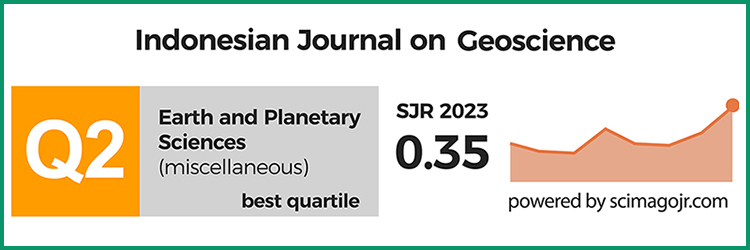Vulkanisme kompleks Gunung Patiayam di Kecamatan Jekulo, Kabupaten Kudus, Provinsi Jawa Tengah
DOI:
https://doi.org/10.17014/ijog.3.2.75-88Keywords:
Mount Patiayam, volcanism, volcanic deposits, pyroclastics, pyroxene basalt, ring-like calderaAbstract
https://dx.doi.org/10.17014/ijog.vol3no2.20082
The Mount Patiayam Complex was interpreted by previous researchers as “Patiayam Dome”. That was reasoned by dips following its slope directions. Field data record that lithology of the complex of Mount Patiayam is dominated by volcanic rocks. The summit of the complex is composed of igneous rocks of pyroxene basalt rich in leucite minerals, associated with autoclastic breccia and beds of volcanic breccia rich in pyroxene basalt and pumice, pumiceous breccia, and tuff. Its flanks are composed of epiclastic rocks of lahar and fluvial deposits. Some river valleys, such as Pontang River, locally consist of pyroclastic breccia, autoclastic breccia and pumiceous breccia, that are overlain by marly limestone and black clay of swampy deposits. Based on the rock composition, the volcanism had more dominated geological processes compared with sedimentary.
Mineral composition of volcanic deposits of the Mount Patiayam is closer to Mount Lasem volcanic rocks than Mount Muria, i.e. absarockites, shoshonites and trachyandesite. But, based on the long distance between Patiayam and Lasem, about 60 km, those volcanic rocks could not be produced by Mount Lasem. The Patiayam volcanic deposits were produced by its own volcanic activities. Therefore, the complex of Mount Patiayam is a paleo-volcano. The interpretation is also supported by the landsat imagery, showing depression-shapes in a caldera ring-like. There are four caldera features called as Rim 1,Rim 2,Rim 3, and Rim 4, which crosses each others.
References
Mulyaningsih, S., 2006. Geologi lingkungan di lereng selatan Gunungapi Merapi Yogyakarta pada masa sejarah (Historical Time). Disertasi S3 Program Pasca-Sarjana Teknik Geologi, Fakultas Ilmu Kebumian dan Teknologi Mineral, Institut Teknologi Bandung, 340 h.
Pararas-Carayannis, G., 1997. Some of the World's Greatest Disasters, Bombay Press., India, 243 h.
Sartono, S., Hardjasasmita, S., Zaim, Y., Nababan, U.P., dan Djubiantono, T., 1978. Sedimentasi Daerah Patiayam, Jawa Tengah. Berita Pusat Penelitian Arkeologi, 19, h.1-21.
Syarifudin, M.Z., dan Hadian, R., 1977. Laporan lapangan pemeriksaan G. Sumbing, Jawa Tengah. BPPTK DIY, Tidak dipublikasikan.
Suwarti, T. dan Wikarno, 1992. Peta Geologi Lembar Kudus, skala 1:100.000. Pusat Penelitian dan Pengembangan Geologi, Bandung.
Van Padang, N., 1951. Catalogue of the Active Volcanoes of the World Including solfatara fields, - Napoli, Italia.
Zaim, Y., 1989. Les formations “Volcano-sedimentaires” Quaternaires de la region de Patiayam (Central Java, Indonesia). Theses Doktorat L’Institut de Paleontologie Humaine, Perancis, Tidak Dipublikasikan, 264 h.
Zaim,Y., 1998. Penelitian paleoekologi dan paleoenvironmen untuk rekonstruksi sejarah kehidupan manusia purba Homo erectus di Jawa berdasarkan penelitian paleontologi vertebrata daerah Patiayam Jawa Tengah. Laporan Penelitian No. 1831207; Ba 560.45/Zai; 99/1039, JBPTITBPP/ITB Central Library Institut Teknologi Bandung.
Zaim, Y., 2006. Hominids in Indonesia: From Homo erectus (paleojavanicus) to Homo floresiensis. Dalam: Sar- tono, S., Dari Hominid ke Delapsi dengan Kontroversi, Penerbit ITB, Bandung, h. 73-86.



















